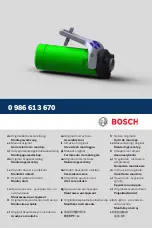
408-10215
Rev
C
8
of 8
9.
MAINTENANCE AND INSPECTION
9.1.
Daily maintenance
Remove dust, moisture, and other contaminants with a clean, soft brush or soft, lint-free cloth.
Do not
use objects that could damage the dies or tool.
When the tool is not in use, keep the handles closed to prevent objects from becoming lodged in the
dies.
Remove all lubrication and accumulated film by immersing the dies in a suitable commercial degreaser.
Store the tool in a clean, dry area.
9.2.
Visual inspection
Inspect the tool and dies on a regular basis to ensure that they are not worn or damaged.
Make sure that the die retaining screws are properly secured.
Inspect the crimping chambers of the die assembly for flattened, chipped, worn, or broken areas.
Close the tool handles until the ratchet releases, and then allow them to open freely. If they do not
open quickly and fully, the spring is defective.
If damage or abnormal wear is evident, replace the tool or dies. Refer to section 10, REPLACEMENT
AND REPAIR.
10.
REPLACEMENT AND REPAIR
If the dies are damaged or worn excessively, they must be replaced. Order replacement dies through your TE
representative. You can also order parts by any of the following methods:
Go to
Shop TE
link at the top of the page.
Call 800-522-6752.
Write to:
CUSTOMER SERVICE (038-035)
TE CONNECTIVITY CORPORATION
PO BOX 3608
HARRISBURG PA 17105-3608
For customer repair services, call 800-522-6752.
11.
REVISION SUMMARY
Revisions to this instruction sheet include:
Converted to TE standard format


























